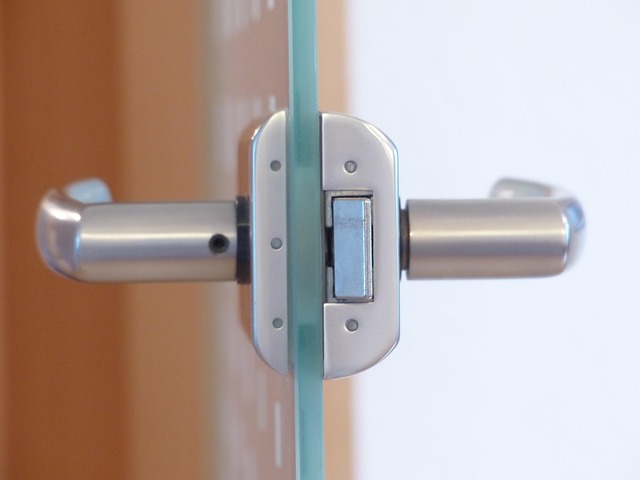Touchless Door Systems: Smart Integration for Enhanced Security and Efficiency

Touchless door systems, powered by sensor technology, revolutionize access control by eliminating ph…….
Introduction
In modern society, the seamless blend of technology and convenience is evident across various sectors, with automatic door systems being a quintessential example of this integration. These systems not only enhance accessibility but also embody innovation in addressing practical challenges. This article delves into the intricacies of automatic door systems, exploring their significance, technological advancements, economic impact, and more. By the end of this exploration, readers will have a comprehensive understanding of these systems and their role in shaping the future of accessibility and convenience.
Understanding Automatic Door Systems
Automatic door systems are engineered to open automatically, eliminating the need for manual operation. They are typically activated by motion sensors, push buttons, or by the approaching presence of an individual with a physical disability. These systems encompass a range of technologies including sliding doors, swing doors, revolving doors, and vertical lift turnstiles. The core components of these systems include door operators, control panels, safety sensors, and power sources.
Historically, automatic door systems have evolved from simple mechanical devices to sophisticated smart systems integrated with IoT capabilities. They have transitioned from being a luxury to an essential element in various settings, including commercial buildings, public spaces, and residential homes. Their significance lies not only in their functionality but also in their ability to cater to the needs of diverse populations, enhancing accessibility and user experience.
Global Impact and Trends
The influence of automatic door systems is felt globally, with adoption rates varying across different regions. North America and Europe lead in market share due to early adoption and stringent accessibility laws. Asia-Pacific is rapidly catching up, driven by economic growth and urbanization. The Middle East and Africa are also seeing an increase in installations, supported by government initiatives for smart city development.
Key trends shaping the trajectory of automatic door systems include the integration of energy-efficient technologies, advancements in safety features, and the adoption of IoT and AI to optimize user experience. The growing awareness of environmental sustainability is also steering the industry towards eco-friendly solutions.
Economic Considerations
From a market dynamics perspective, the automatic door systems sector is driven by factors such as technological advancements, regulatory changes, and consumer preferences. Investment patterns reflect a shift towards smart and sustainable access control solutions. These systems not only contribute to the economic value of buildings but also play a crucial role in disaster management by facilitating quick egress during emergencies.
Technological Advancements
The technological evolution of automatic door systems has been remarkable, with advancements such as biometric access control, AI-driven predictive maintenance, and energy harvesting to power operators. These innovations not only enhance security but also contribute to sustainability and efficiency. The future holds promise for even more sophisticated technologies like voice recognition and augmented reality interfaces.
Policy and Regulation
Policies and regulations governing automatic door systems are influenced by safety standards, accessibility requirements, and energy consumption guidelines. In the United States, for example, the Americans with Disabilities Act (ADA) sets forth specifications to ensure that these systems are accessible to all individuals. The European Norms (ENs) provide a framework for product safety and performance. Compliance with these regulations is not only mandatory but also drives innovation within the industry.
Challenges and Criticisms
Automatic door systems face challenges such as reliability concerns, maintenance issues, and high initial costs. Criticisms often highlight the potential for system failure or security breaches. To overcome these issues, manufacturers are focusing on improving robustness and developing cost-effective solutions that are accessible to a broader market. Strategies include enhancing quality control processes, investing in research and development, and creating educational programs to inform users about optimal usage and maintenance.
Case Studies
Several case studies exemplify the successful application of automatic door systems. For instance, the integration of these systems in hospitals has improved patient flow and reduced the risk of cross-infection by minimizing manual door handling. Retail spaces have leveraged these systems to enhance customer experience and streamline store operations. These success stories underscore the tangible benefits that automatic door systems offer.
Future Prospects
Looking ahead, automatic door systems are poised for growth in various sectors. Smart cities will increasingly adopt these systems as part of their infrastructure. The healthcare sector will continue to benefit from improved accessibility and infection control. Retail, hospitality, and corporate environments will further integrate these systems to cater to consumer demands for seamless experiences.
Conclusion
Automatic door systems are a testament to the power of technology to enhance convenience and accessibility. They represent a significant advancement in how we interact with physical spaces. This article has explored their multifaceted impact, from economic considerations to technological innovations, and the regulatory frameworks that guide their development. As automatic door systems continue to evolve, they will undoubtedly play an integral role in shaping the future of accessibility and convenience.
FAQ Section
What are automatic door systems?
Automatic door systems are devices designed to open on their own, often triggered by motion sensors or push buttons, without requiring manual intervention.
What are the main components of an automatic door system?
The main components include the door operator (the motor that moves the door), control panel (to manage the operation of the door), safety sensors (to detect obstructions and prevent injuries), and power source (usually electrical or battery-operated).
Are there any regulations governing the installation of automatic door systems?
Yes, in places like the United States, the Americans with Disabilities Act (ADA) provides guidelines to ensure these systems are accessible and functional for all individuals. In Europe, European Norms (ENs) set safety and performance standards.
What are some of the challenges faced by automatic door systems?
Challenges include ensuring reliability and durability, maintaining high security levels, and managing initial costs. Addressing these issues requires a commitment to quality manufacturing, continuous innovation, and proper maintenance.
How are automatic door systems becoming more sustainable?
Through the integration of energy-efficient technologies, renewable energy sources, and predictive maintenance algorithms, these systems are becoming more environmentally friendly and cost-effective to operate.
This summary encapsulates the key points discussed in the article, providing readers with a concise overview of automatic door systems’ multifaceted role in modern society.

Touchless door systems, powered by sensor technology, revolutionize access control by eliminating ph…….

Automatic entry doors revolutionize access control with seamless convenience and enhanced security……..

Automated door solutions have evolved from conveniences to stylish architectural accents, offering a…….

Automatic door repair services are essential for maintaining accessibility in public spaces, alignin…….

Automatic doors, while convenient, can waste energy due to poor insulation and weather seals. Automa…….

Automatic entry doors, driven by mechanical and electronic components like motors, sensors, and cont…….

Motion sensor doors are transforming access control by offering a seamless blend of convenience and…….

Automatic door systems, powered by electrical or hydraulic mechanisms, offer space-saving benefits a…….

Automatic door systems revolutionize building access with unparalleled convenience, security, and en…….